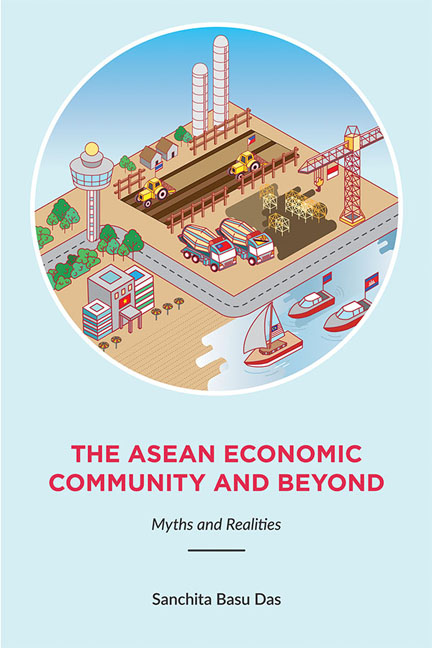Book contents
- Frontmatter
- Dedication
- Contents
- Foreword
- Acknowledgements
- Abbreviations
- 1 Introduction: The ASEAN Economic Community and Beyond
- I THE ASEAN ECONOMIC COMMUNITY (AEC)
- II BEYOND THE ASEAN ECONOMIC COMMUNITY
- 9 The Regional Comprehensive Economic Partnership: Going Beyond ASEAN+1 FTAs
- 10 Comparing ASEAN+1 FTAs for an Effective RCEP
- 11 Challenges in Negotiating the Regional Comprehensive Economic Partnership Agreement
- 12 The Next Decade in ASEAN-U.S. Economic Relations
- 13 RCEP and TPP: Comparisons and Concerns
- 14 The Trans-Pacific Partnership (TPP): Economic and Strategic Implications for the Asia-Pacific
- 15 The Trans-Pacific Partnership as a Tool to Contain China: Myth or Reality?
- 16 RCEP and TPP: Can They Converge into an FTAAP?
- 17 Is APEC's Relevance Fading?
- III AN ASEAN PERSPECTIVE OF REGIONAL CONNECTIVITY
- Appendix: Summary of the Trans-pacific Partnership Agreement
- Index
- About the Author
14 - The Trans-Pacific Partnership (TPP): Economic and Strategic Implications for the Asia-Pacific
from II - BEYOND THE ASEAN ECONOMIC COMMUNITY
Published online by Cambridge University Press: 19 May 2017
- Frontmatter
- Dedication
- Contents
- Foreword
- Acknowledgements
- Abbreviations
- 1 Introduction: The ASEAN Economic Community and Beyond
- I THE ASEAN ECONOMIC COMMUNITY (AEC)
- II BEYOND THE ASEAN ECONOMIC COMMUNITY
- 9 The Regional Comprehensive Economic Partnership: Going Beyond ASEAN+1 FTAs
- 10 Comparing ASEAN+1 FTAs for an Effective RCEP
- 11 Challenges in Negotiating the Regional Comprehensive Economic Partnership Agreement
- 12 The Next Decade in ASEAN-U.S. Economic Relations
- 13 RCEP and TPP: Comparisons and Concerns
- 14 The Trans-Pacific Partnership (TPP): Economic and Strategic Implications for the Asia-Pacific
- 15 The Trans-Pacific Partnership as a Tool to Contain China: Myth or Reality?
- 16 RCEP and TPP: Can They Converge into an FTAAP?
- 17 Is APEC's Relevance Fading?
- III AN ASEAN PERSPECTIVE OF REGIONAL CONNECTIVITY
- Appendix: Summary of the Trans-pacific Partnership Agreement
- Index
- About the Author
Summary
The Trans-Pacific Partnership (TPP) is an ambitious agreement that aims at a regular FTA with provisions for protecting intellectual property; at the creation of investor-friendly regulatory frameworks and policies; and at emerging issues, including measures to ensure that state-owned companies “compete fairly” with private companies and do not put the latter at a disadvantage. It is developed to create a strong alternative template to advance U.S. economic and strategic interests in Asia, following the collapse of Doha Round and global economic slowdown in 2008. The TPP, if successful, will seek not only to deepen regional integration but also to facilitate trade through production networks, most of which comprise of trade in Asia. This is expected to be much more comprehensive compared to current bilateral and regional FTAs. The economic value of TPP would depend on what could be finally agreed upon and hence could be included in the final agreement. Implementation integrity from all TPP members would also be a key to its potential success. However, with a range of new issues, these will require significant reforms in domestic industrial and economic policies of most members, which will make negotiations tough. Strategically, TPP is viewed largely as a manifestation of Comprehensive Economic Partnership for East Asia (includes ASEAN+6 members) versus East Asia Free Trade Area (includes ASEAN+3 members) tension. The TPP is also viewed as a part of the ongoing Sino-U.S. rivalry, especially evident from absence of China's participation in the regional pact.
INTRODUCTION
TPP, originally known as the Trans-Pacific Strategic Economic Partnership Agreement, is a nine member free trade agreement that aims to enhance economic integration in the Asia-Pacific region by further liberalizing trade and investment. The original agreement with membership of Brunei, Chile, New Zealand, and Singapore, was signed on 3 June 2005 and entered into force on 28 May 2006.
Five additional countries — Australia, Malaysia, Peru, the United States, and Vietnam — are negotiating to join the TPP, potentially taking the membership to nine. This will bring the combined GDP to US$16.7 trillion (26 per cent of the global GDP) and total trade worth US$5 trillion. In addition, Japan, Korea, Mexico and Canada have also expressed their interest in joining the negotiations. With their economies in the partnership, the TPP will represent US$26 trillion of combined GDP, or 41 per cent of the global GDP.
- Type
- Chapter
- Information
- The ASEAN Economic Community and BeyondMyths and Realities, pp. 150 - 156Publisher: ISEAS–Yusof Ishak InstitutePrint publication year: 2015

